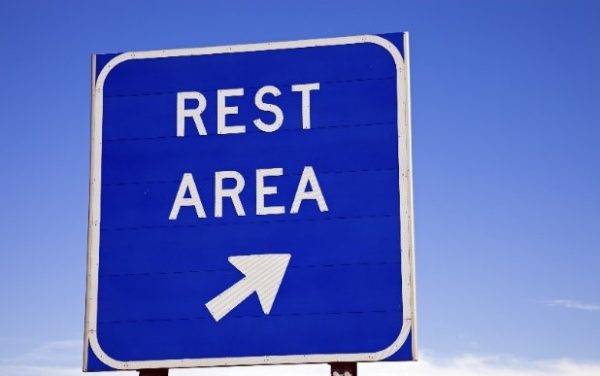I am being compensated by Astellas Pharma US, Inc. for this post; however, the opinions expressed here are my own.

If only I got frequent flyer goer miles
I’m dancing with a group …and…DON’T JUMP is running through my mind…repeatedly.
The song begins and I see their feet ALL leave the floor at the exact same second that I begin to RUN as fast as I can. Running has become a regular thing for me. It’s just too bad that I don’t do it for exercise.
Running or walking with your legs crossed is an art form, doing it with ease (that includes NO WINCING, SQUEAKS, or using your hands) is a masterpiece when you have an overactive bladder (OAB) symptoms like I do (with extra points for keeping a smile on your face as you bolt for whichever restroom is available).
Once I got over the embarrassment of talking to my friends about it (YES, they noticed), I learned that about 46 million American adults age 40 and older experience OAB symptoms (at least sometimes).1 I am one who has NOT YET talked to my doctor because, well…I’m embarrassed. I’ve always had the urge to go more often than my friends, even when I was a teenager, and as a travel blogger, road trips are a nightmare for me, because I gauge distance by rest stops.

You’ll find THESE tucked in my handbag.
Sometimes I need a little push to make the first move, and after learning of the “Peehavior” survey results of 2,854 women conducted by Astellas, I have the courage to talk about it. Why? Because knowing that so many of us experience the same symptoms of OAB, and with only about 1 in 8 actually talking to their doctor about it, I felt like I needed to be one of the voices to speak up about the problem.2
What I learned
- Many Americans live with symptoms of overactive bladder (OAB), such as peeing too often and feeling the urgent need to go.3
- Approximately 46 million American adults age 40 and older experience overactive bladder symptoms at least sometimes.1
- As few as 1 in 8 women with symptoms of overactive bladder may seek treatment.2
- One of the symptoms of overactive bladder (OAB) is frequency: the need to urinate often — usually 8 or more times a day.3
- For people with overactive bladder, the brain sends incorrect signals to the bladder, causing it to contract before it’s full.4
- If you experience urgency, you may not be able to wait to go. Leakage is also known as accidentally urinating after a sudden, uncontrollable urge.3
- Many people with overactive bladder plan their daily activities around their frequent need to urinate.5
- Everyone pees, but not everyone’s experiences are the same.
- OAB is a diagnosable medical condition for which treatments are available.3
- A healthcare professional may offer treatment options if you have some or all of these symptoms.
Where I fit in
I have been one of those women who has used the men’s bathroom (checking first of course) because I couldn’t wait in line, and while I haven’t peed in the bushes, I do have a travel pee cup that that I take JUST IN CASE. I have been able to hide it fairly well, but every now and then I worry that I might smell of urine (hence the perfume that I carry) from leakage.
Women age 55+ are more likely to not confide in anyone when it comes to frequently visiting the bathroom (to pee).6 I understand completely. It’s embarrassing.
Since I started writing this post
I’ve peed four times. Last night I slept no more than 2 hours at a stretch because I had to pee. OAB affects my life more than I like to think, and starting today I’m going to Stop Stalling and call my doctor.

- If you think you are affected by OAB, you can learn more about what to do at StopStalling.com

References:
- Coyne KS, Sexton CC, Vats V, Thompson C, Kopp ZS, Milsom I. National community prevalence of overactive bladder in the United States stratified by sex and age. Urology 2011;77(5):1081-7.
- Milsom I, Kaplan SA, Coyne KS, Sexton CC, Kopp ZS. Effect of bothersome overactive bladder symptoms on health-related quality of life, anxiety, depression, and treatment seeking in the United States: results from EpiLUTS. Urology 2012;80(1):90-6.
- Gormley EA, Lightner DJ, Burgio KL, et al. Diagnosis and treatment of overactive bladder (non-neurogenic) in adults: AUA/SUFU guideline. American Urological Association Education and Research, Inc. 2014.
- Sadananda P, Drake MJ, Paton JFR, Pickering AE. A functional analysis of the influence of β3-adrenoceptors on the rat micturition cycle. J Pharmacol Exp Ther 2013;347(2):506-15.
- Filipetto FA., Fulda KG, Holthusen AE, McKeithen TM, McFadden P. The patient perspective on overactive bladder: a mixed-methods needs assessment. BMC Family Practice 2014;15:96-101.
- Astellas and Ipsos Public Affairs. Data on File.
I am being compensated by Astellas Pharma US, Inc. for this post; however, the opinions expressed here are my own.
Click to Add Tracking Pixels
